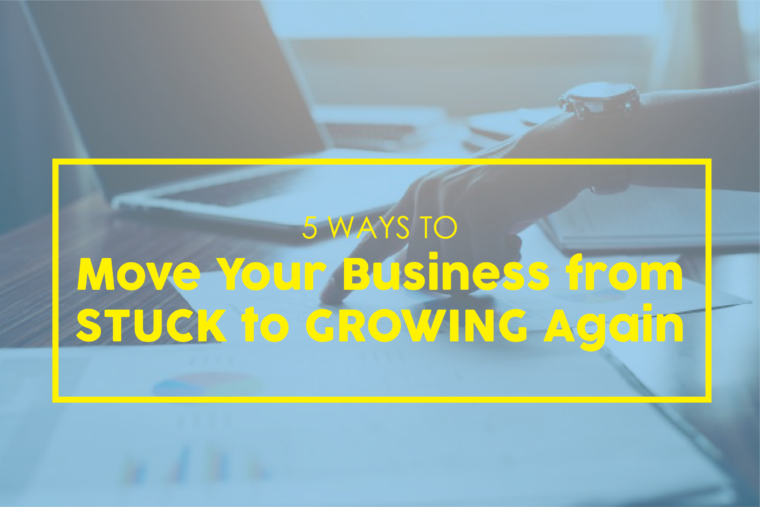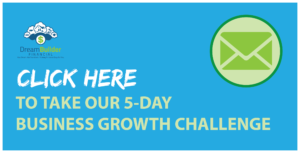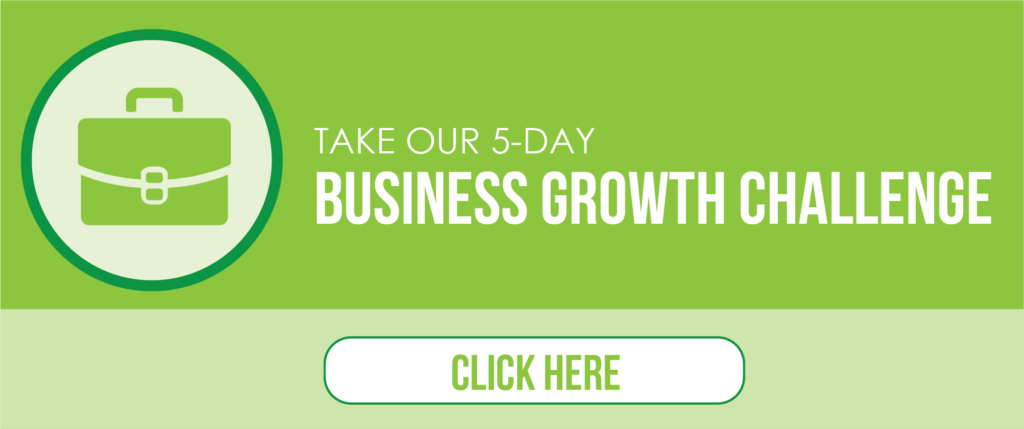
I started my business the same way as many others: while working a job and balancing a very busy family life.
Initially, I made some progress and quickly earned my first $10,000 in revenue. That’s when I hit my first brick wall. I couldn’t get to the next level. All I wanted was to move to the 4-figure per month club.
Be careful what you ask for, because I figured out the next steps and I hit that mark. I soon discovered that there was another brick wall in my future. Once again I was stuck, this time at about $60,000 in annual revenue.
At that point I was wondering why some people seemed to have it all figured out, making it look so easy.
What was I doing wrong?
I started to question if I had what it took to make it with my business. It is a recipe for disaster when you start doubting your own abilities.
I set out to find what I was doing wrong. In this process of self reflection, testing and learning from others, I discovered 5 key ingredients causing novice entrepreneurs to struggle. The sooner that you and I can get past them, the faster our businesses can grow into one with routine 5-figure months.  The 5 key ingredients? Here they are:
The 5 key ingredients? Here they are:
- Expound On Your Why, Your Ideal Client, and The Problem to Solve
The truth is, this is a lot and can really be three separate steps – heck, probably three separate posts. As a matter of fact, there are books written on each one of these.What are they, you ask? Let’s start with your “Why”. The “why” is the innate purpose of the business you are building. It is the vision that you have that goes beyond money. It is ingrained in the fabric of the business, employees, and customers.In his book Start With Why, Simon Sinek gives the example of the well known company Apple, who decided that their purpose was to “challenge the status quo,” their whole existence was suddenly different. Customers know that their Apple product will be different and unique and challenge the boundaries of where technology has gone before. Your business needs a core reason for its’ existence, the purpose it was started in the first place.
The ideal client, sometimes referred to as your target avatar or buyer persona, is the person or people you most want to target with your marketing campaigns based on your current business situation. Your current clients aren’t always necessarily your ideal clients.Most likely, you reading this blog post, are a small business owner who has yet to reach 6 figures in revenue. I can make this assumption because I targeted my ideal clients by starting the post talking about my experiences at that stage in my business. The intention was for people who related to those feelings to identify with the material and keep reading. That was me putting targeting my ideal client into practice.Finally, the question that you must ask: What is the problem that your ideal client has that you are trying to solve? What are their frustrations? What does their perfect future look like? Ryan Deiss, the CEO of Digital Marketer, calls this knowing your client’s “Before and After State”. Since I love that terminology, I’ll be using it here.
These 3 key pieces of information – Why, Ideal Client and their Before and After State – are the pillars or foundation of all the marketing you do for your business. This will drive the conversations that you have and the products you create.
I found that that I had these all wrong. I had approached the problem by asking myself, “What do I want to sell,” instead of figuring out what my ideal client would need, to have the straightest path from their Before State to their After State.
This brings us to our second point:
- Choose ONE product or service
When we start our business and release our first product or service, we begin to attract buyers. However, sometimes the buyers want something different than what we have to offer, so we expand that offer to include what they want. What also happens is that we don’t see fast enough growth and in our minds we blame the offer (the positioning of the product/service i.e., price, scarcity, features, etc.) for not being attractive enough. So we add more products and services in the hopes that more offers will bring in more business.This is a huge misstep that I made and I see others frequently making as well. It makes sense that we would react this way, however, it is just as easy to see why it is a mistake.You only need one product to get to 5 figures per month. If it is a high ticket product, say a $2,000 per month offer, then you only need to sell five of your product and you’ve reached your goal. Conversely, a lower priced offering would need a greater volume of sales (for example a $100 product would have to be sold to 100 customers to achieve the same $10,000 of revenue). Assuming that there are enough potential customers seeking your solution, this also seems very doable.
Now that we established that this is easily doable with one offer, let’s analyze what the problem is with multiple offers. Every offer you create requires a sales message to close the deal. It then requires fulfillment and support on the back-end. James Wedmore, one of the great online marketers and business acceleration coaches said that you should be spending 80% of your time selling. To be able to make that happen with a small team or no team at all, you need to be able to replicate the efforts to service one client so that less time is spent servicing future clients.
With one offer, you can standardize the sales conversation, formalize the proposal and then create a standardized process for delivering the product or service and supporting the customer. The key at this stage is doing as little work as possible on the fulfillment side of the business so that you can focus on selling.So how do you choose the right one?Choosing the right service or product becomes a lot easier when you have properly identified and gotten to know your ideal client. Remember that the goal is to provide a straight path from their current, “before” state to their desired, “after” state. You can understand this by mapping out the journey your client needs to take, and, after understanding their needs, you create a product or service that takes them past those first few steps of their journey.
For example, the natural first step for my ideal client, the struggling or stuck new business owner, is to go through the steps on this page and then implement the changes. I do this with a free, live five-day challenge that guides them, people like you, through these 5 steps in a basic form. I then offer my Six Figures in a Year membership program designed to provide step-by-step direction and support through their journey.
Okay, you’ve narrowed down your offering to one single solution. Now how do you sell it?
- Choose ONE Marketing and Sales Plan
Similar to number 2 above, the focus should be on finding a marketing and sales plan that works and then sticking with it. You’ll have plenty of time to get fancy later. The key to understand here is that when it comes to the marketing and sales strategy there is a difference from the exercise we just did regarding the product or service.
With selecting a product or service, YOU are the expert, so you are the one who knows exactly what they need, no guessing involved. When it comes to marketing and sales, you have to keep testing until you find something that works. One mistake I see very often is that the metrics (or data) are not interpreted properly, and, as a result, the wrong analysis is made.Let’s say that you decide to sell a product or service through a challenge, as I described earlier. For the purpose of this example let’s assume that a good rate of conversion is 3%, which means that for every 100 people signed up for the challenge, there are 3 sales made.
Now you run your very first challenge and you get 30 people signed up for the challenge and you make 2 sales. Many people would say at that point, “I put in all this time and effort and only got 2 sales, this doesn’t work.” They then scrap the efforts and try the next plan.
What they don’t see is that they converted at a rate of 6.7% (2/30 = .067), more than twice the average conversion rate!
The right next move is to figure out how to get even more people to participate in the challenge and run it again. Instead, most of us will pivot and try something else instead.
There is another common error that is made when the data is not yet statistically relevant. Now before your eyes glaze over, bear with me for a moment. Using the challenge example from above, let’s say nobody purchased. This looks like a 0% conversion rate, which nobody wants. The problem is that the average rate is exactly that, an average. Sometimes you get 0/100 and 6/100 on two separate attempts.
The second lesson here is that you may need to try enough times that you went through a large enough sample set (statistical jargon for the total number of people). For our example, you probably want to run enough challenges to have between 500 and 1,000 total participants before making a decision about whether or not it is successful.
In order to do this right, it is imperative to have the right numbers and then understand your metrics, bringing us to numbers 4 and 5.
- Run the Numbers
Picking the price point of your offer is not arbitrary. You need to run your business like a business and make sure you’re bringing in the money that you should be. When discussing the size of your business, I’ve focused on the top-line revenue, but what good is earning $10,000 in a month if it cost you $11,000 to get it?
Figuring out the numbers means identifying the price point of your product and testing the profitability based on a series of assumptions. Being a Profit First Professional, we will use the author of Profit First, Mike Michalowicz’s, formula. Profit First guidelines for a business with less than $250k in revenue dictates the following breakdown of every revenue dollar:
Profit – 5% (.05)
Owner’s Compensation – 50% (0.5)
Tax – 15% (.15)
Operating Expenses – 30% (0.3)As long as we know one of the 5 variables, we can determine the remainder. The simplest one to determine is the Operating Expenses. For example, let’s assume, for simplicity, that advertising expenses are 50% of total operating expenses. We can further assume that a lead will cost $4 (this is an example, the cost for a lead or referral can be far less or greater and varies tremendously from one business and industry to the next).
If we anticipate a 3% conversion (3 out of every 100 leads will purchase), then each sale will cost $133.33 ($4/.3), in advertising dollars, and, therefore, $266.66 ($133.33 x 2) in total operating expenses. Now we can easily fill in the rest of our numbers:
Revenue (Price) – $888.87 (266.66 / 0.3)
Profit – $44.44 (5% of Revenue)
Owner’s Compensation – $444.43 (50% of Revenue)
Tax – $133.33 (15% of Revenue)
Operating Expenses – $266.66 (already calculated)Given our cost assumptions, we have determined that the product must be sold for $889 which could be rounded to a nice marketing figure of $897. Here’s the test: does your product provide at least $897 of value? If your product is a simple baby pacifier then probably not. However, if the pacifier miraculously does sleep training for an infant, it may very well be able to command that price.
Another way to look at this is to think of your ideal client and ask yourself, is this product or service worth this price to them if it delivers the promised result, taking them further on their journey to their After State.
Many entrepreneurs skip the simple mathematical calculation above and arbitrarily choose a price for their product or service. Thousands of dollars later, they wonder why they can’t make money no matter how many units, hours or packages they sell. Worse, they are making money but not enough that they cannot get the benefit from their business that they desire.
- Reverse Engineer the Metrics
You’ve come this far and this is the final piece of the puzzle. The metrics – assuming you focus on the right ones – dictate to you exactly where to focus your efforts. Many entrepreneurs spend a lot of time on things that will not directly drive the results of selling their one product or service. Although it is possible that much of what they are doing will be necessary, at this stage, getting the business to 5 figure months is far more important.
- Yearly Financial Goal:
The first thing you need is a financial goal for the year. Let’s assume that the business is brand new and wants to be at $10,000/month by the end of the year. So we have a clearly defined year-end goal. - Quarterly Financial Goal:
Now we need a quarterly goal. Quarterly goals are critical because you should not focus your day to day efforts on a result that can only be measured more than 90 days in the future. We are all human and you have a very high likelihood of giving up before then.The simple method to calculate the quarterly goal would be to divide the yearly goal in 4 and arrive at a quarterly goal. However, at the beginning of the process there is a lot of testing and failing before succeeding. Therefore we want to be realistic and assume that growth will snowball over time. Instead, as a rule, I assume percentages to completion as follows:Q1: 5%
Q2: 15%
Q3: 30%
Q4: 50%Translated into dollars for our $10,000 per month goal, here is what our monthly revenue should look like at the end of each quarter:
Q1: $500 ($10,000 x 5%)
Q2: $2,000 ($10,000 x 15% + Q1)
Q3: $5,000 ($10,000 x 30% + Q1 + Q2)
Q4: $10,000 ($10,000 x 50% + Q1 + Q2 + Q3) - Determine the Number of Units to be Sold:
Once you have a financial goal, it is time to work backwards using the selling price we arrived at in the previous step. For our example, our selling price is $897. Using the numbers above we need to sell the following number of units per Quarter:Q1: 1-2 units ($500 x 3 months = $1,500 / $897 = 1.67)
Q2: 6-7 units ($2,000 x 3 months = $6,000 / $897 = 6.69)
Q3: 16-17 units ($5,000 x 3 months = $15,000 / $897 = 16.72)
Q4: 33-34 units ($10,000 x 3 months = $30,000 / $897 = 33.44)Note: The above calculations were done this way to avoid confusing you, however, the quarterly dollar amounts were the end of quarter targets, therefore, you may not see the unit numbers listed until the following month.
- Determine the Action to be Taken Today that can be Measured:
Now that we know how many units need to be sold, we can back the math into the promotion we want to run. Say for example we are running a challenge. Let’s also assume, the same number as earlier, that 3% of challenge sign-ups will become buyers. If we need to sell 2 units, we need to get 67 (2/.03) people into our challenge. If we need to sell 16 units we need to get 533 (16/.03) people into our challenge.Now we know that our one and only job is to figure out how to get 67 people signed up for our challenge in Q1.
To get people to buy we need to have them participate until the end. We could take these examples further by analyzing our advertising metrics, email open rates etc.
At this point, you need to pat yourself on the back. The last 2 key points were very math heavy and you could have gotten lost. You’re still here, so you followed me through.
- Yearly Financial Goal:
Now you know exactly how to get your business on the growth path again. You also do not have to go through this process alone. Simply join our 5-Day Business Growth Challenge and you’ll have a whole community of entrepreneurs traversing this journey with you!


